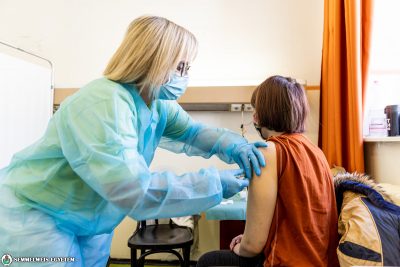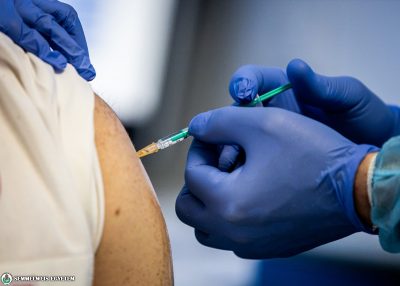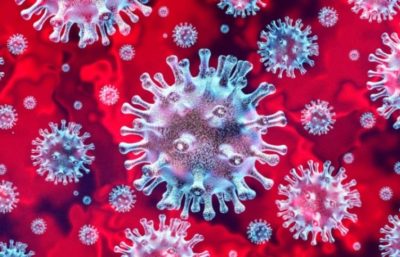General mask use seems not only reduce to the rate of new infections, but also increases the number of asymptomatic cases. According to a recent article published in the New England Journal of Medicine and summarized by Dr. Béla Merkely, this may be due to the fact that wearing a mask reduces the number of virus particles getting in contact with the wearer.
As SARS-CoV-2 continues its global spread, it’s possible that one of the pillars of Covid-19 pandemic control, universal facial masking, might help reduce the severity of disease and ensure that a greater proportion of new infections are asymptomatic. If this hypothesis is confirmed, universal mask wearing could become a form of “variolation” that would generate immunity and thereby slow the spread of the virus in the United States and elsewhere, as we await a vaccine. The above is published in the article Facial Masking of COVID-19 – potential for “variolation” as we await the vaccine published in the New England Journal of Medicine.
The reason for wearing masks across the whole population became apparent in March, when reports described the rates of SARS-CoV-2 viral shedding from the noses and mouths of patients who were presymptomatic or asymptomatic were equivalent to those among symptomatic patients. Universal facial masking may possible way to prevent transmission from asymptomatic infected people. On 3 April, the Centers for Disease Control and Prevention (CDC) in the United States recommended that the public wear cloth face coverings in areas with high possibility of community transmission. However, this recommendation has not been followed uniformly across the United States. A guide to homemade masks and the of wearing facial masks was published on Semmelweis University’s website on 22 April.
Based on past evidence related to other respiratory viruses, wearing a facial mask can also protect the wearer from becoming infected, by blocking viral particles from entering the nose and mouth. Epidemiologic investigations around the world, especially in Asian countries where people are accustomed to wearing masks across the population during the 2003 SARS pandemic, have suggested that there is a strong correlation between public masking and pandemic control. Recent data from Boston demonstrate that SARS-CoV-2 infections decreased among health care workers after universal masking was implemented.
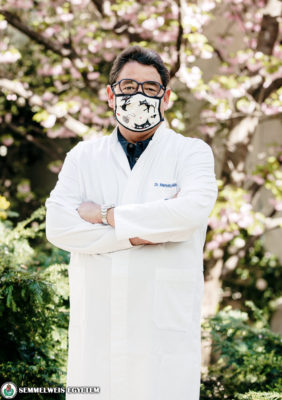 SARS-CoV-2 can cause a large number of clinical manifestations, ranging from a complete lack of symptoms to pneumonia. Recent virologic, epidemiologic, and ecologic data have led to the hypothesis that wearing facial masks may also reduce the severity of disease among people who do become infected. This possibility agrees with a long-standing theory of viral pathogenesis, meaning that the severity of disease is proportionate to the viral inoculum received. Since 1938, researchers have been conducting experiments primarily in animal models on the concept of the lethal dose of a virus. In other words, they have been trying to pinpoint the dose at which 50% of exposed hosts die (LD50). With viral infections, such as SARS-CoV-2, in which host immune responses play a predominant role in viral pathogenesis, high doses of viral inoculum can overwhelm and dysregulate innate immune defenses, increasing the severity of disease. Therefore, down-regulating immunopathology by the steroid dexamethasone improves outcomes in severe Covid-19 infection. The correlation between the amount of virus particles and the severe manifestations of the virus has been demonstrated in a Syrian hamster model of SARS-CoV-2 infection.
SARS-CoV-2 can cause a large number of clinical manifestations, ranging from a complete lack of symptoms to pneumonia. Recent virologic, epidemiologic, and ecologic data have led to the hypothesis that wearing facial masks may also reduce the severity of disease among people who do become infected. This possibility agrees with a long-standing theory of viral pathogenesis, meaning that the severity of disease is proportionate to the viral inoculum received. Since 1938, researchers have been conducting experiments primarily in animal models on the concept of the lethal dose of a virus. In other words, they have been trying to pinpoint the dose at which 50% of exposed hosts die (LD50). With viral infections, such as SARS-CoV-2, in which host immune responses play a predominant role in viral pathogenesis, high doses of viral inoculum can overwhelm and dysregulate innate immune defenses, increasing the severity of disease. Therefore, down-regulating immunopathology by the steroid dexamethasone improves outcomes in severe Covid-19 infection. The correlation between the amount of virus particles and the severe manifestations of the virus has been demonstrated in a Syrian hamster model of SARS-CoV-2 infection.
If the number of viral particles determine the severity of SARS-CoV-2 infection, a hypothesized reason for wearing facial masks would be to reduce the number of viral particles to which the wearer is exposed and the clinical impact of the disease. Since masks can filter out some virus-containing droplets (depending on the mask type), wearing masks might reduce the amount of virus particles that is exhaled by an infected person. If this theory is confirmed, wearing masks across the poulation might contribute to increasing the proportion of asymptomatic SARS-CoV-2 infections. According to CDC reports, the typical rate of asymptomatic infection with SARS-CoV-2 was about 40% in mid-July, but now asymptomatic infection rates are reported to be higher than 80% thanks to universal facial masking. Countries that have adopted population-wide masking have fared better in terms of the rates of severe Covid-related illnesses and death. Another experiment in the Syrian hamster model simulated surgical masking of the animals and showed that hamsters with simulated masking were less likely to get infected, and if they did get infected, they were either asymptomatic or had milder symptoms than unmasked hamsters.
The most obvious way to spare society the devastating effects of COVID-19 is to promote measures reducing both transmission and severity of illness. On the other hand, SARS-CoV-2 is highly transmissible, cannot be contained emphasizing its symptoms. It has proved difficult to eradicate even in regions that implemented strict initial control measures. Efforts to increase testing and containment in the United States have been ongoing and variably successful. Vaccines are awaited not just for infection prevention, but for its ability to decrease the severity of the disease. Most vaccine trials include a secondary outcome of decreasing the severity of illness, therefore increasing the proportion of cases in which disease is mild or asymptomatic would be a public health victory.
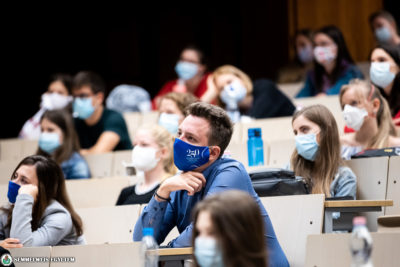 Universal masking seems to reduce the rate of new infections; it is hypothesized that by reducing the number of viral particles the proportion of infected people who remain asymptomatic would also increase. For example, in an outbreak on a closed Argentinian cruise ship, where passengers were provided with surgical masks and staff with N95 masks, the rate of asymptomatic infection was 81% (as compared with 20% in earlier cruise ship outbreaks without universal masking). In two recent outbreaks in US food-processing plants, where all workers wore masks each, the proportion of asymptomatic infections among the more than 500 people who became infected was 95%, with only 5% in each outbreak experiencing mild-to-moderate symptoms. Fatality rates in countries with mandatory or enforced population-wide masking have remained low, even with resurgences of cases after lockdowns were lifted.
Universal masking seems to reduce the rate of new infections; it is hypothesized that by reducing the number of viral particles the proportion of infected people who remain asymptomatic would also increase. For example, in an outbreak on a closed Argentinian cruise ship, where passengers were provided with surgical masks and staff with N95 masks, the rate of asymptomatic infection was 81% (as compared with 20% in earlier cruise ship outbreaks without universal masking). In two recent outbreaks in US food-processing plants, where all workers wore masks each, the proportion of asymptomatic infections among the more than 500 people who became infected was 95%, with only 5% in each outbreak experiencing mild-to-moderate symptoms. Fatality rates in countries with mandatory or enforced population-wide masking have remained low, even with resurgences of cases after lockdowns were lifted.
Despite concerns regarding safety, the world has high hopes for an effective SARS-CoV-2 vaccine, and as of early September, 34 vaccine candidates participated in clinical evaluation, with hundreds more in development. While waiting for the results of vaccine trials, any public health measure that could increase the proportion of asymptomatic SARS-CoV-2 infections may both make the infection less deadly and increase population-wide immunity. Reinfection with SARS-CoV-2 seems to be rare, despite more than 8 months of circulation worldwide and as suggested by a macaque model.
The scientific community has been clarifying for some time the adaptive immune response to SARS-CoV-2 and the inadequacy of antibody-based seroprevalence studies. Promising data have been emerging in recent weeks suggesting that strong cell-mediated immunity results from even mild or asymptomatic SARS-CoV-2 infection, so any public health strategy that could reduce the severity of disease could increase population-wide immunity as well. To test the hypothesis that population-wide masking is one of those strategies, further studies are needed comparing the rate of asymptomatic infection in areas with and areas without universal masking. To test the variolation hypothesis, we will need more studies comparing the strength and durability of SARS-CoV-2–specific T-cell immunity between people with asymptomatic infection and those with symptomatic infection, as well as a demonstration of the natural slowing of SARS-CoV-2 spread in areas with a high proportion of asymptomatic infections. Combating the pandemic will involve reducing both transmission rates and severity of disease. Increasing evidence suggests that population-wide facial masking might benefit both.
The summary of Dr. Béla Merkely, Rector is based on the article „Facial Masking for Covid-19 – Potential for “Variolation” as We Await a Vaccine” by Monica Gandhi, M.D., M.P.H. and George W. Rutherford, M.D. published in the New England Journal of Medicine.
Photo (portrait): Attila Kovács – Semmelweis University
Featured image (illustration): Zoltán Adrián
